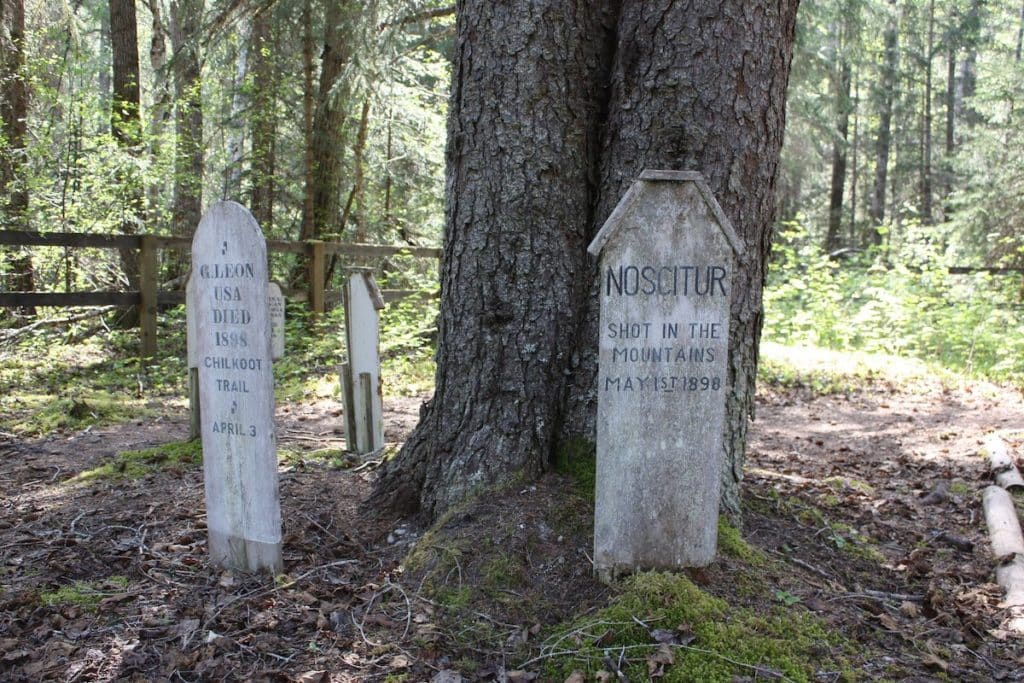Alaska is really big. Many of us know that is the largest state in the US (sorry, Texas) and is three times as big as France!
With a rich history, wild nature, and crazy stories, there are some parts of the state that time seems to have forgotten. History buffs, adventure seekers, and even some lucky tourists may stumble across these sites that are frozen in time.
Alaska is home to countless abandoned buildings, towns, and mines, all throughout the state. With Gold Rush booms and busts, it is no surprise that so many buildings and towns became abandoned.
If you are looking to learn more about Alaska’s past history, we have rounded up some of our favorite abandoned places in Alaska to explore.
1.) Buckner Building
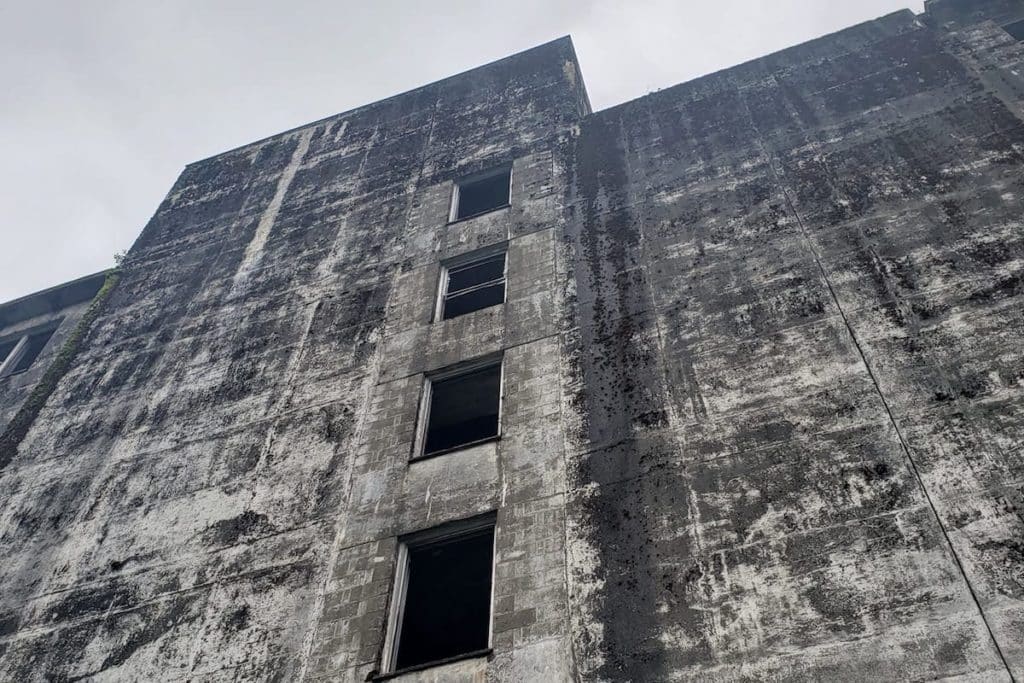
The Buckner Building lies abandoned on the western edge of Alaska’s Prince William Sound.
Originally built as a military building, the Buckner Building is now one of the most famous abandoned places in the US, with its fair share of speculation and rumor surrounding it.
During the early days of WWII, there was concern that Alaska could be attacked by air. General Simon Buckner, the defensive commander of Alaska at the time, recommended building a protective shelter that was bomb-proof and independent from local power plants to protect his troops.
The building was soon known as “the city under one roof,” featuring a jail, 320-seat movie theater, bowling alley, and cafeteria.
The building continued to operate until 1966, when the military pulled out of port Whittier and after changing hands several times, went into foreclosure in 2016. Demolishing or restoring the property would be quite costly, so the building sits abandoned to this day.
You can see this exceptional building in person next time you are in Whittier, but don’t try to enter. The building is in extensive disrepair and has been deemed unsafe. The city will fine anyone who trespasses onto the property.
- Address: Hill St Whittier AK 99693
2.) Ester Gold Camp

Ester Gold Camp was opened as a large scale dredge operation in 1936. The gold camp included a bunkhouse, dining hall, smaller bunkhouses, homes, offices, and even shops!
After Fairbanks closed mining operations in the 1950s, new owners converted it into the Cripple Creek Resort. In the 1980s the property underwent a rebrand to Ester’s Gold Camp.
Ester Gold Camp closed to tourists in 2008, but it was bought by new owners.
You can now find the gold camp and additional saloon back up and running for visitors to enjoy! This is a great stop in Fairbanks for a not-so-spooky abandoned attraction.
They are open seasonally from May through September. They are open Wednesdays through Sundays. And charge a $5 cover at Malamute Saloon on Friday and Saturday nights.
Ester Gold Camp
- Address: 500 Alpha Way Fairbanks AK 99709
- Email: [email protected]
- Website: malemutesaloon.com
- Social Media: Facebook | Instagram
3.) Fortymile Region

Fortymile River in east Alaska features hundreds of miles of creeks and rivers. In 1886, gold was found there and prospectors named the river. Miners then extracted more than a half-million ounces of gold from the Fortymile watershed during its Gold Rush years.
Largely abandoned during the Klondike Gold Rush when gold was discovered nearby, visitors can still visit the Fortymile Region and see the remnants of past mining operations that litter the beaches.
The best part? The Fortymile River has a large number of access points, making it possible to enjoy float trips that range from one day to several weeks in length. That means you can cruise past Alaska’s history for as long as you want.
4.) Portlock
Portlock, Alaska is a ghost town on the Kenai Peninsula. Located just 16 miles south of Seldovia, this small town began as a cannery in the early 1900’s.
Starting in the early 1940s, some Dall sheep hunters went missing in the woods. Shortly after, some of the missing hunters dismembered body parts began washing ashore. It did not take long for the entire town to evacuate; the post office ended up closing between 1950 and 1951.
Dozens of people went missing over a 20 year span, and many of the locals attributed it to Nantinaq, or a giant Bigfoot or Yeti type creature.
And this wasn’t the first time something like this happened. The locals claim that this legend has been around for hundreds of years. In fact, there is evidence of a previous community at the same Portlock townsite that had been abandoned years prior.
Whatever this creature may be, many people won’t go back to the village area. When the cannery needed workers to finish, they had to hire armed guards to watch over them during their entire stay.
Portlock is currently abandoned, and likely to remain so, if the legends are true!
5.) Fort Egbert

Built in the late 1800s by the US Army, Fort Egbert had a population of 1,700 people by 1899. It was located in a strategic spot on the Yukon, and was a center for trade and transportation for the interior of Alaska.
It was abandoned in 1911, though an Army Signal Corps contingent stayed behind to run a telegraph and wireless station until 1925. By the 1970s, only 36 intrepid souls stayed on in town. Not long after, the city’s historic district was named a National Historic Landmark.
Today, 5 of the original 45 buildings are still intact, and managed by the Bureau of Land Management, the National Park Service, and Eagle Historical Society and museums. If you are traveling the Taylor Highway from April through October, consider stopping at Fort Egbert.
You can explore the grounds on your own, and learn more about Alaska’s history with the Klondike Gold Rush. Spend the night at Eagle Campground, just a short walk from the center of Fort Egbert.
Eagle Campground has 18 campsites, as well as several outhouses. It is a great place to spend the weekend if you want to learn more about the history of this abandoned town.
- Address: 4th Ave Eagle AK 99738
6.) Kiska Island
Kiska is a small island in the Aleutian Islands. During WWII, the Japanese took control of the island for over a year. However when the US and Canadian allied forced attempted to retake the island in 1943, they did not realize that the Japanese had already left. They opened fire on themselves in the dense fog, and several others died in booby traps the Japanese had set before they left.
Today, Kiska Island stands frozen in time. It’s been named a National Historic Landmark, even though there are no monuments or permanent installations.
However, you can still find bullet casings, remains of Japanese ships, and other wartime debris left where it fell over half a century ago. Most of these relics remain untouched since 1943.
Currently, Kiska Island has no remaining population on the island.
7.) Independence Mine

The Independence Mine State Historical Park is an inactive mine located in Hatcher Pass, just a short drive from Palmer, Alaska. When you visit this historical park, you can step into what the lives of the miners must have been like during the Gold Rush!
Two local mines were consolidated in 1938, becoming the Independence Mine. The mine closed in 1951 after mining 6 million dollars worth of gold.
You can now visit this historic site the next time you visit Hatcher Pass. Walk the well-maintained trails, where you can gaze at the relics of this successful gold mine.
You can begin your self-guided tour of the Independence Mine State Historical Park at the Mine Manager’s House. This house is the location of both the Visitor Center and museum. Inside you will see numerous displays about natural history, mining, and the history of the Independence Mine.
Follow this up with a self-guided interpretive tour through the mine camp along the paved trails. Soak in the sights of the nearby Talkeetna Mountains, and enjoy your day!
Fees are $5 per vehicle for a day-use pass. The mine is open for exploration from mid-June through Labor Day.
- Address: 23264 Gold Cord Rd Palmer AK 99645
- Website: dnr.alaska.gov
8.) Igloo City
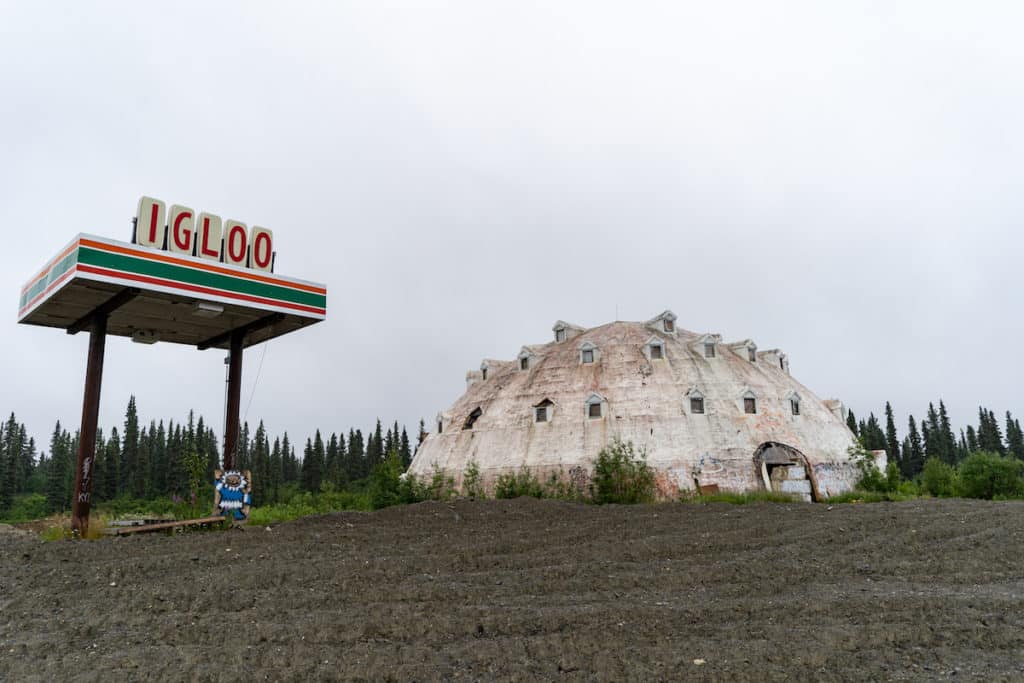
Igloo City is the tourist attraction that never was.
The four story building was built in the 1970s, but did not meet building codes at the time. It was originally intended to be a unique hotel, but due to code issues it never opened for business.
The building is so large that it can be spotted from airplanes flying as high as 30,000 feet. Over the years, people have broken into the building and vandalized it. It is privately owned, and anyone attempting to enter it is considered to be trespassing.
Its current purpose is a marker point as halfway between Fairbanks and Anchorage on the Parks Highway. Many travelers know they are halfway between both when they pass the iconic Igloo City.
- Address: Mile 188.5 Parks Hwy, Denali National Park and Preserve, AK 99755
9.) Ukivok
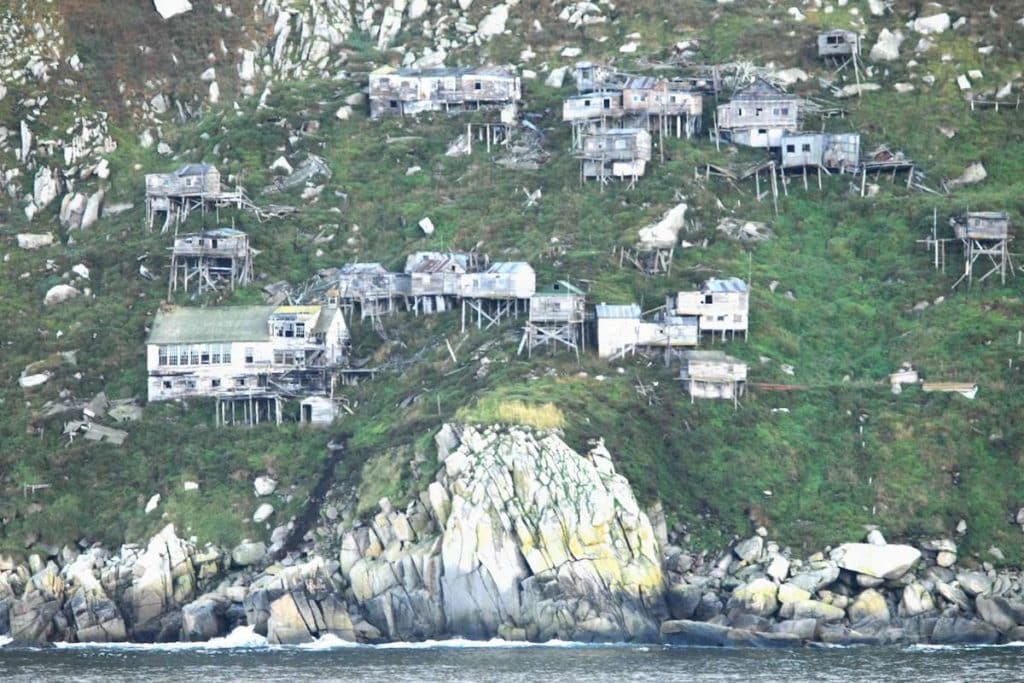
King Island is one of the most remote places in Alaska.
This small and rugged island is only about a mile wide. It is located about 40 miles from mainland Alaska, and 90 miles to its nearest town of Nome.
However, for many years the small town of Ukivok thrived on the steep and rocky slopes of this island. Home to about 200 cliff-dwelling denizens, all the buildings of Ukivok were set on stilts. Although they have been abandoned since the mid 1990s, most of the structures exist to this day.
The homes, perched on the side of cliffs above the icy sea, are now all abandoned. After Bureau of Indian Affairs closed the local island school, the Aseuluk children were forced to return the the mainland.
The rest of the families soon followed, as gathering the winter food without the younger generation was too difficult.
In recent years, local researchers have worked to allow some members of the original population to return. Perhaps some day in the future it will be a ghost town no more!
10.) Kennecott Mines

Kennecott Mines were a copper mine operating deep within the Wrangell – St. Elias National Park. These iconic bright red buildings hold a long and storied history of early 20th Century copper mining.
The mine was in full swing from 1911 through 1938, moving $200 million worth of copper ore on the Copper River Railroad.
It was a bustling spot, with over 300 workers living their during its peak. The mining town boasted a hospital, worker homes and a bunkhouse, general store, school, skating rink, tennis court, recreation hall, and even a dairy!
In 1939 the Kennecott Copper Corporation left the site after exhausting the large copper mines. The National Park Service purchased the land and acquired all mineral rights in 1998.
This was after the Kenencott Mines were added to the National Register of Historic Places in 1978, and designated as a National Historic Landmark in 1986.
Now you can come visit these once deserted buildings, as the National Park Service works to slowly restore them to their former glory.
Open in the summer from mid-May through mid-September, visiting the town is free. Explore on the many trails through the area, check out the General Manager’s Office, the General Store and Post Office, and more!
You can easily spend an entire weekend soaking in the local history on your next visit to this National Historic Landmark.
- Address: Kennicott, Chitina, AK 99566
- Website: nps.gov
11.) Slide Cemetery
Located in Skagway, and accessed through the Klondike Gold Rush National Historic Park, this abandoned cemetery tells the story of the intrepid gold rush miners who came through the area but lost their lives.
On Palm Sunday, April 3rd, 1898, an avalanche struck the busy Chilkoot Trail. This trail was the route many miners took through the pass to get to the Klondike Gold Fields.
Even though spring conditions called for an avalanche, and locals warned the newcomers who were hiking the trail, the advice went unheeded and many miners continued up the trail.
The series of small snow slides ended up taking the lives of more than 48 men. Some say the death toll is as high as 100. The bodies that were found were buried in the wilderness cemetery of Slide Cemetery, located just north of Dyea Campground.
The avalanche marked the end of the once-busy Chilkoot Trail, and the town of Dyea quickly moved from a boom town to deserted ghost town.
- Address: Slide Cemetary Trail, Skagway, AK 99840
12.) Portage Ghost Town
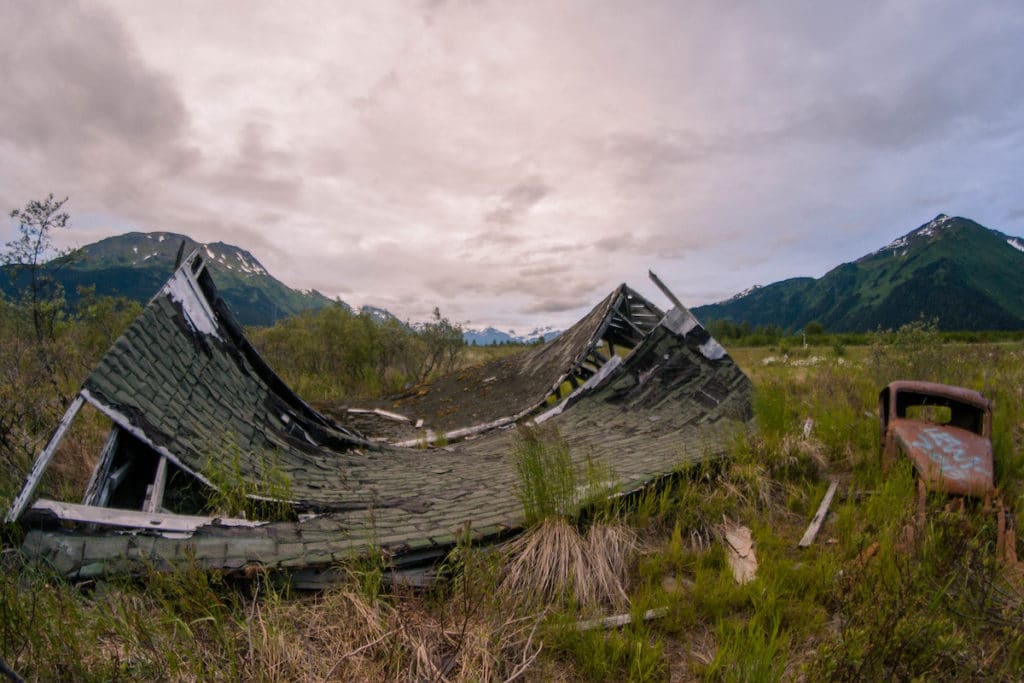
Located right on the Seward Highway is the small ghost town of Portage.
Decimated in 1964 by the Good Friday earthquake – the second largest earthquake ever recorded on earth – this small town was hit hard by the 4 minute and 38 second earthquake.
One local Portage resident claimed that the earthquake felt like riding an elevator in his home. When the earthquake finished, the entire town was demolished. For safety reasons, the townspeople relocated their home to Girdwood.
All that remains now are the abandoned homes and the skeletal remains of a barren forest.
- Address: About 47 Miles SE Of Downtown Anchorage
13.) Adak

Adak, located on the Aleutian Islands, is a town with the same name as the island it resides on. Formerly known as Adak Station, this was a United States military outpost during both World War II and the Cold War.
Once the wars ended, however, the base was shut down and abandoned. At its peaked, it housed more than 6,000 military personnel and their families.
Adak Station was home to a college, chain restaurants, and local watering holes. The town was busy, and you could even find a movie theater, swimming pool, and roller skating rink.
When the military downsized in 1994, it closed Adak Station. Today, less than 300 people reside in this once bustling community. Many of the buildings are abandoned and being reclaimed by nature.
14.) Dyea

Dyea, a once famous Gold Rush town, is now a part of the Klondike Gold Rush National Historic Park.
Becoming a busy boomtown during the gold rush in 1897-1898, the history of Dyea is an interesting one. Long before the town blew up with gold-fever, it was a permanent village and seasonal fishing camp for locals.
Located at the base of Chilkoot Pass, it was the perfect spot for trade with the interior First Nations people. In 1879, U.S. Navy Commander L.A. Beardsley arranged an agreement with Chilkat Tlingits.
Miners would be allowed to use the passes to reach the Yukon, but would not interfere with the locals regular trade routes.
In the 1880s Dyea began to grow with its very first trading post, Healy & Wilson Trading Post. This supply and information point was important for the travelers coming through and heading to the gold fields.
When the boom hit Dyea in 1897, the town had more than 150 small businesses. There were restaurants, hotels, attorneys, hospitals, and even real estate agents. A school was built, although it only ran from 1898 through 1900.
Dyea and Skagway were on a similar growth pace until the fateful Palm Sunday Avalanche. The avalanche killed somewhere between 50-100 men, and the town began to slump soon after.
After a fire at the US Army Camp at the Dyea-Klondike Transportation Company, the town continued to shrink. By 1903, less than 6 people lived in the now small town.
The remaining structures were slowly demolished by floods and reclaimed by the forest. In February, 1978, the National Park Service purchase the now ghost down Dyea and turned the area into the Klondike Gold Rush National Historic Park. You can visit this deserted town in person!
- Address: Dyea, Skagway Alaska 99840
What do you think of these abandoned places? Have you ever visited any of these abandoned towns, mines, or buildings?
Does the forgotten past of Alaska intrigue you? If it does, make sure to check out these 12 ghost towns that you probably have never heard of.
After living over 14 years in Alaska, Megan McDonald can confidently state that there’s not much of the state on the road system that she hasn’t visited. From the Brooks Range to McCarthy, Homer, and everywhere in between, every nook and cranny of Alaska is always her new favorite place.
As President and co-founder of Alaska-based boutique media agency HuMu Media, she spends her work time writing, photographing, and traveling, and her off time writing, photographing, and traveling. They say do what you love, and she is lucky enough to do so!
You can follow her travels on Instagram at @theitinerantginger

